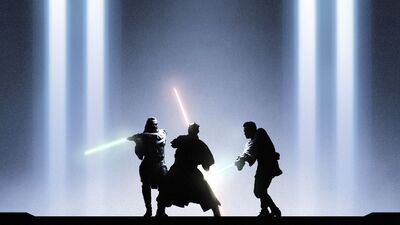I saw “The Phantom Menace” at the now-defunct Ziegfeld movie palace in New York with my wife and my younger brother, also major fans of the series. We walked out in muted silence, then spent the next few hours trying to convince ourselves that we’d had a good time. We had to admit that, except for the three-way lightsaber duel, the pod race sequence, Liam Neeson’s gravitas as Qui-Gon Jinn, and a few design elements, it was an altogether tedious and frustrating experience.
Imagine a dumpster filled with metal tools. Now imagine that there were a few pieces of candy in there, and it was your job to find them.
I went back to see it again a few days later, thinking there had to have been something to it, something I’d failed to appreciate the first time. I didn’t see anything that contradicted my original impression. Armond White described George Lucas’ movie as “magisterial but leaden,” a perfect turn of phrase. Watching “The Phantom Menace,” you knew you were watching a movie made by somebody in complete command of their craft, operating with absolute confidence, as well as the ability to make precisely the movie they wanted to make and overrule anyone who objected. (Surely someone thought about asking Lucas if they really needed to do stereotypical “foreign” accents on some of the bad guys, instead of subtitling nonhuman languages like they did in the original trilogy; but if they did, they kept their mouths shut.)
But despite the absolute freedom with which it was devised, “The Phantom Menace” seemed lifeless somehow. A bricked phone. See it from across the room, you’d think that it was functional. Up close, a paperweight.

That being said, I liked the second half of the next movie, “Attack of the Clones,” quite a bit, and loved almost all of “Revenge of the Sith,” and ended up appreciating the totality of the franchise because (1) it was an epic tragedy that seemed to be pitched towards middle-schoolers, which is something you don’t see every day, and (2) in terms of formal construction, it’s a fascinating object, one that perhaps has more in common with gallery installations than most narrative cinema. Camille Paglia called the prequel trilogy “the greatest work of art in any medium of the last 30 years,” thanks mainly to its formal properties, which in the third movie turned “Star Wars” into, as she put it, a “digital art-piece.”

